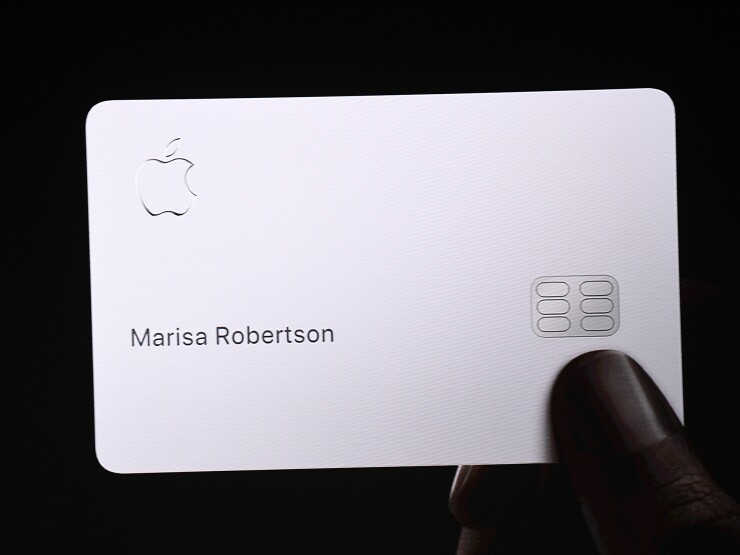It's no accident that Apple chose metal as the material for its physical Apple Card. In the eyes of many consumers, metal makes a card stand out as a status symbol for a premium brand — but their issuers may not think metal is worth the investment.
Recent research indicates that some bank customers would consider switching banks for the status of having a metal card in their wallet. Others are willing to compromise by converting their cards to metal on their own.
More than half of global consumers, at 58%, said metal cards are a competitive differentiator and they would feel more positively about their bank if it offered metal payment cards. Nearly half of U.S. consumers, at 45%, felt the same way. The allure of a metal card most popular in the minds of Chinese consumers at 86% and those in India at 83%, according to research from Edgar, Dunn & Co. for metal card manufacturer CompoSecure.

Half of consumers globally said they would leave their bank for another that offered a metal payment card, assuming that its benefits and rewards were equal to what they already had. Of the U.S. consumers, 33% said they would switch to a bank offering a metal card. The yearlong research surveyed 18,000 consumers in 18 markets globally.
There is an alternative — if the bank doesn't offer metal cards, consumers can get them individually through a company like San Jose, Calif.-based Lion Credit Card, which converts a consumer's current plastic card into a metal one.
For the past three years, Lion Credit Card has seen business expand and is most definitely along for the ride in what the research reveals — that tossing a metal card on the counter at the point of sale has some meaning.
"Everyone wants to have a card that makes them feel rich or they have VIP status," said Lion CEO Jonny Vu. "We have all sorts of customers from young to old and all ethnicities, and we have customers who don't just want one or two cards converted."
Some consumers will have as many as seven of their cards made into metal cards. "I am just amazed by that," Vu admitted.
While Lion can convert the magnetic stripe and EMV chips on cards to metal, it cannot convert the contactless "tap and pay" technology. This is not a major concern to those using metal cards, Vu said.
"They want to be able to show off their custom-made metal card, and you can't do that if you are just doing tap and pay," he added. "They will do contactless with their mobile devices if they want to."
Mostly, Vu said, it seems that those converting plastic to metal cards simply want to keep the rewards and loyalty programs they have in place — but their banks aren't offering metal cards. Others simply are underbanked and want to convert the debit or prepaid cards they use into status-symbol metal.
While the launch of the metal Apple Card validated that consumers have a strong desire and interest in having premium cards, CompoSecure CEO Jon Wilk said, it was also encouraging for him to see such a high interest in metal cards across many markets.
"Clearly, it's a bigger investment for an issuer than a traditional plastic card, but the research supports the consumers' desire for that premium card," Wilk said.
As metal cards become more prevalent, the question remains whether they can
Apple obviously thought so, choosing the sleek titanium card from Goldman Sachs for its physical Apple Card. But that metal card complements the digital Apple Card inside of the iPhone, a place where Apple prefers payments be made through Apple Pay. In that regard,
Still, consumers have to be cautious about why they would switch payment cards, let alone the banks issuing them, said Brian Riley, director of card services for Mercator Advisory Group.
"The metal cards are cool, there is no question about that," Riley said. "I love the look and feel of the metal cards, but you have to keep in mind that the real important part of the card is the terms and agreements."
It is highly important that the consumer understand the interest rates on the card, Riley said. "You don't want to have a shallow relationship with your card company based only on the fact that it is a cool card," he added.
There have been many interesting designs and concepts for payment cards in the past, including clear plastic cards, and those of various colors and materials, Riley said. "But if the interest rates are higher, you are paying a lot for that metal card."
CompoSecure's Wilk agrees in that "an important combination in a strong value proposition is adding rewards and loyalty and having the metal card as a differentiator."
Sixty-five percent of all consumers surveyed said they would choose a metal card over a plastic one, if all things were equal. In emerging countries with growing middle classes, the desire for metal cards and premium programs was high, at 91% in China and 88% in Mexico.
As for affluent consumers, 75% globally said they would choose metal cards, while 80% in the U.S. felt that way.
Consumers said that durability and the "look and feel" of metal cards were important factors, though those in Asia mentioned it was important to use the metal card to "make an impression."





